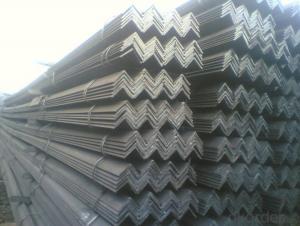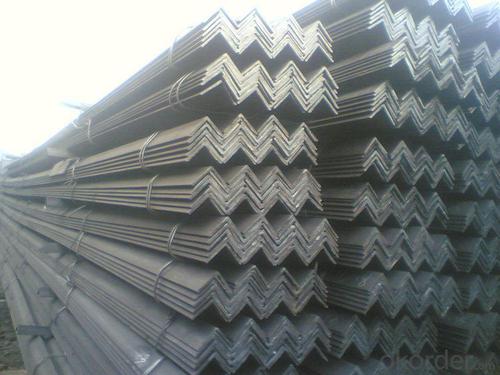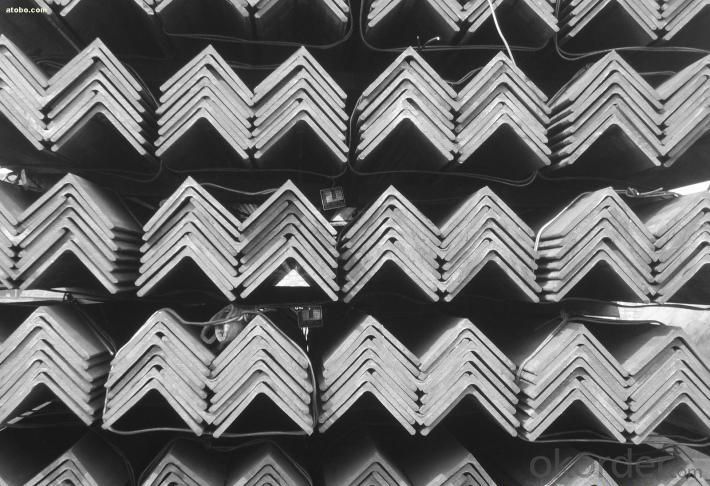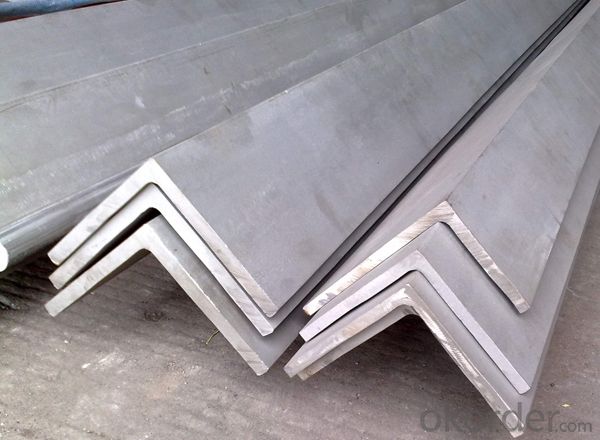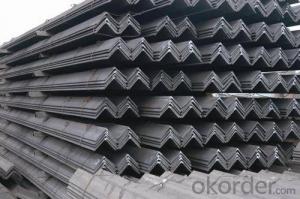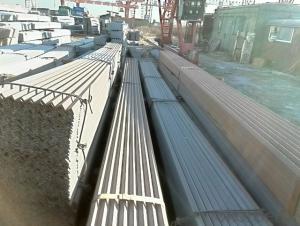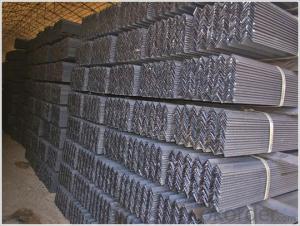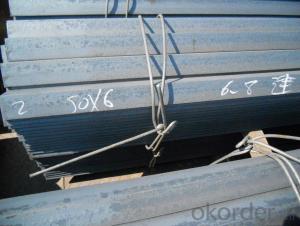Hot Rolled Steel Angle with Good Quality with The Size 120*120mm
- Loading Port:
- Tianjin
- Payment Terms:
- TT OR LC
- Min Order Qty:
- 50 m.t.
- Supply Capability:
- 10000 m.t./month
OKorder Service Pledge
OKorder Financial Service
You Might Also Like
Application: Hot Rolled Angle Steel is widely used in many fields like the communication tower, beam and rafters of the houses,and bridge. And it is also can be used to be the connection material between different steel structure parts.
Features:
Different Sizes: 50*50mm---250*250mm
Different Standards:GB Standard, JIS Standard, En Standard

Sizes: 25mm-250mm | ||
a*t | ||
25*2.5-4.0 | 70*6.0-9.0 | 130*9.0-15 |
30*2.5-6.6 | 75*6.0-9.0 | 140*10-14 |
36*3.0-5.0 | 80*5.0-10 | 150*10-20 |
38*2.3-6.0 | 90*7.0-10 | 160*10-16 |
40*3.0-5.0 | 100*6.0-12 | 175*12-15 |
45*4.0-6.0 | 110*8.0-10 | 180*12-18 |
50*4.0-6.0 | 120*6.0-15 | 200*14-25 |
60*4.0-8.0 | 125*8.0-14 | 250*25 |
- Q: What are the different testing methods used for quality control of steel angles?
- To ensure compliance with industry standards and specifications, steel angles undergo various testing methods for quality control. These methods encompass: 1. Visual Inspection: This method involves visually examining the steel angles for surface defects like cracks, pits, or irregularities. By identifying obvious defects, visual inspection safeguards the structural integrity and appearance of the angles. 2. Dimensional Inspection: By measuring the dimensions and tolerances of the steel angles, this method ensures adherence to the required specifications. Dimensional inspection is particularly crucial for applications that demand precise measurements to maintain accuracy and consistency. 3. Mechanical Testing: Evaluating the mechanical properties of steel angles, such as strength, hardness, and ductility, is done through mechanical testing. This involves subjecting the angles to loads or forces and measuring their response, including tension, compression, or bending. Mechanical tests commonly conducted on steel angles include tensile testing, hardness testing, and impact testing. 4. Chemical Analysis: Determining the chemical composition of the steel angles is performed through chemical analysis. This is essential as different steel grades have specific composition requirements to achieve desired mechanical properties. Chemical analysis confirms the presence and quantity of key elements such as carbon, manganese, sulfur, and phosphorus. 5. Non-Destructive Testing (NDT): NDT methods allow inspection of steel angles without causing any damage. Techniques like ultrasonic testing, magnetic particle testing, liquid penetrant testing, and radiographic testing are employed to detect internal defects, cracks, or abnormalities not visible through visual inspection. 6. Surface Finish Inspection: As steel angles may undergo surface treatments like galvanizing or painting, surface finish inspection assesses the quality and uniformity of these treatments. It ensures proper adherence to specified requirements, enhancing corrosion resistance and aesthetics. 7. Microscopic Examination: Microscopic examination involves using a microscope to inspect the microstructure of the steel angles. This method reveals any internal defects or abnormalities that may compromise the structural integrity of the angles. By utilizing these testing methods, manufacturers and quality control personnel guarantee that steel angles meet the necessary specifications and standards, certifying their reliability and suitability for diverse applications.
- Q: Can steel angles be used for support structures in stadiums or arenas?
- Yes, steel angles can be used for support structures in stadiums or arenas. Steel angles are commonly used in construction and engineering projects due to their strength, durability, and versatility. They are often utilized in structural applications where load-bearing support is required, making them suitable for supporting the weight of stadium or arena structures. Steel angles can be used as beams, columns, or trusses to provide the necessary support and stability for large structures. Their ability to withstand heavy loads and resist bending or warping makes them a popular choice for constructing stadium roofs, grandstands, and other support systems. Additionally, steel angles can be easily fabricated and customized to meet specific design requirements, allowing for efficient and cost-effective construction of stadium and arena support structures.
- Q: What are the different types of steel angles used in automotive manufacturing?
- Automotive manufacturing relies on a variety of steel angles that play a crucial role in designing and constructing automotive structures and parts. Some of the commonly utilized steel angles in this industry include: 1. Equal Angle: This type of steel angle consists of sides of equal length, forming a 90-degree angle. In automotive manufacturing, equal angles find applications in chassis frames, suspension components, and brackets. 2. Unequal Angle: As the name suggests, unequal angles have sides of unequal lengths, creating a 90-degree angle. Automotive manufacturers employ unequal angles to fabricate components with specific dimensions and angles, such as door frames, body reinforcements, and support structures. 3. L Angle: Also known as angle irons, L angles possess two sides of equal length that form a 90-degree angle. They are extensively used in automotive manufacturing for various purposes, including reinforcing panels, mounting brackets, and structural supports. 4. T Angle: Resembling the shape of the letter "T," T angles consist of one long side and one short side forming a 90-degree angle. In automotive manufacturing, T angles play a significant role in joining different components like body panels, fenders, and roof structures. 5. C Angle: Referred to as channel angles, C angles have a C-shaped cross-section. These angles offer structural strength and rigidity, making them suitable for applications such as frame rails, roll cages, and support beams in automotive manufacturing. 6. Z Angle: Z angles feature a Z-shaped cross-section, resembling the letter "Z." They are commonly employed in automotive manufacturing to join and reinforce components like door frames, roof structures, and body reinforcements. These examples merely scratch the surface of the numerous types of steel angles employed in automotive manufacturing. Each type serves a specific purpose and possesses unique properties, such as strength, stability, and flexibility, to meet the diverse requirements of automotive applications.
- Q: Can steel angles be used for solar panel installations?
- Yes, steel angles can be used for solar panel installations. Steel angles provide structural support and stability for solar panels when they are mounted on rooftops or other structures. They are commonly used to create a framework or mounting system that securely holds the panels in place. Steel angles are strong and durable, able to withstand the weight of the panels and any external forces such as wind or snow loads. Additionally, steel angles can be easily fabricated and customized to fit specific installation requirements, making them a versatile choice for solar panel installations.
- Q: What is the typical corrosion rate of steel angles?
- The typical corrosion rate of steel angles can be influenced by various factors, such as environmental conditions, the type of steel utilized, and the presence of protective coatings. In general, steel angles are prone to corrosion due to their iron content. However, by properly maintaining them and applying protective measures, the corrosion rate can be significantly reduced. In mild atmospheres or indoor settings with low humidity and minimal exposure to corrosive substances, the corrosion rate of steel angles tends to be relatively low, typically ranging from 0.1 to 0.5 mils per year (1 mil equals 0.001 inches). This slow corrosion rate enables steel angles to maintain their structural integrity for a long time. On the other hand, in more aggressive environments like coastal areas with high salt levels in the air or industrial settings with chemical exposure, the corrosion rate can be considerably higher. In these scenarios, the corrosion rate of steel angles can range from 0.5 to 2 mils per year, or even higher. It is crucial in such environments to implement measures such as regular inspection, cleaning, and the application of protective coatings to mitigate the corrosion rate and extend the lifespan of the steel angles. It is important to note that these corrosion rates are estimated averages, and actual rates may vary depending on the specific conditions and factors mentioned earlier. Seeking advice from a corrosion engineer or utilizing corrosion rate data specific to the environment and steel type can provide a more accurate estimation of the typical corrosion rate for steel angles in a particular situation.
- Q: What are the different methods for reinforcing steel angles?
- Depending on the specific structural needs and design requirements, there are various methods available for reinforcing steel angles. Some commonly used methods are as follows: 1. Welding is the most frequently employed technique for reinforcing steel angles. By using heat and pressure, two or more steel angles can be joined together to create a strong and durable connection. To maintain the integrity of the reinforcement, it is crucial to follow proper welding techniques and procedures. 2. Bolting is another method that can be utilized to reinforce steel angles. This involves inserting bolts through holes in the angles and tightening them to establish a secure connection. This method is often preferred when adjustability or removability of the reinforcement is necessary. 3. Riveting, a traditional technique, can also be employed to reinforce steel angles. It entails inserting a pin or rivet through holes in the angles and securing it by deforming the pin's end. This creates a robust and permanent connection between the angles. 4. Adhesive bonding can be used in certain cases to reinforce steel angles. This method involves applying a specialized adhesive to the surfaces of the angles and pressing them together. As the adhesive hardens, it forms a strong bond between the angles. 5. Plate strengthening is an option for additional reinforcement. Steel plates can be attached to the angles, typically through welding or bolting, to enhance their strength and load-bearing capacity. 6. Reinforcing bars, commonly referred to as rebar, can also be employed to reinforce steel angles. These bars are typically embedded into the concrete or masonry structure and extend into the angles to provide additional strength and support. To determine the most suitable method for reinforcing steel angles based on specific project requirements and structural considerations, it is essential to consult with a structural engineer or design professional.
- Q: Can steel angles be used in the construction of theatres?
- The utilization of steel angles in theatre construction is indeed possible. Their strength and versatility make them common structural components in construction. They offer stability and support, making them suitable for various theatre construction applications. Steel angles can be employed in theatres to establish the framework for stage platforms, catwalks, and balconies. They can also be used to support lighting fixtures, rigging systems, and sound equipment. Additionally, they can reinforce the structural integrity of the theatre building itself, such as beams, columns, and trusses. The advantages of using steel angles in theatre construction are plentiful. Firstly, steel is a durable and long-lasting material, ensuring the stability and safety of the theatre structure over time. Moreover, steel angles can be easily customized and fabricated to meet specific design requirements, allowing for flexibility in theatre construction. Furthermore, steel angles possess fire-resistant properties, which are of utmost importance in theatre environments where fire safety is a priority. They can withstand high temperatures and provide structural support even in the event of a fire, guaranteeing the safety of both the building and its occupants. Overall, steel angles are an excellent choice for theatre construction due to their strength, versatility, and fire-resistant properties. They furnish the necessary structural support and stability required for the unique needs of theatre spaces, ensuring a safe and functional environment for performances and audiences alike.
- Q: What are the different surface treatments for steel angles?
- There are several different surface treatments available for steel angles, each designed to enhance their durability, appearance, and resistance to corrosion. Some of the common surface treatments for steel angles include: 1. Hot-dip galvanizing: This process involves immersing the steel angles in a bath of molten zinc, which forms a protective coating on the surface. Galvanizing provides excellent corrosion resistance and is ideal for outdoor applications where the angles may be exposed to moisture and harsh weather conditions. 2. Powder coating: Powder coating involves applying a dry powder paint to the surface of the steel angles. The angles are then heated, causing the powder to melt and form a smooth, durable coating. Powder coating provides a wide range of color options and improves the angles' resistance to chipping, scratching, and fading. 3. Electroplating: Electroplating involves depositing a layer of metal onto the surface of the steel angles through an electrochemical process. Common metals used for electroplating include zinc, nickel, and chrome. Electroplating provides both aesthetic appeal and enhanced resistance to corrosion. 4. Priming and painting: Priming and painting involves applying a layer of primer followed by a coat of paint to the steel angles. Priming helps improve adhesion and provides a smooth surface for the paint to adhere to. Painting not only enhances the appearance of the angles but also provides some protection against corrosion. 5. Anodizing: Anodizing is typically used for aluminum angles rather than steel, but it can also be applied to steel. This process involves creating an oxide layer on the surface of the angles by subjecting them to an electrolytic process. Anodizing improves the angles' corrosion resistance, hardness, and color stability. It is important to choose the appropriate surface treatment for steel angles based on the specific application and environmental conditions they will be exposed to. Each treatment offers unique benefits in terms of corrosion resistance, aesthetics, and durability, so carefully considering these factors will help ensure the longevity and performance of the steel angles.
- Q: How do steel angles perform under static or stationary loading conditions?
- Steel angles are commonly used in construction and engineering applications due to their strength and versatility. Under static or stationary loading conditions, steel angles exhibit excellent performance and stability. Static loading refers to a situation where a load is applied to the angle and remains constant without any motion. Steel angles are specifically designed to withstand such loading conditions. Due to their structural properties, steel angles have a high resistance to bending and twisting forces. This allows them to effectively support heavy loads without experiencing significant deformation or failure. Steel angles distribute the applied load evenly along their length, which helps to minimize stress concentrations. This property ensures that the angle can efficiently transfer the load to the supporting structure, providing stability and structural integrity. Additionally, steel angles can withstand compressive forces, which try to shorten or compress the material. The shape and cross-section of steel angles, specifically their L-shaped profile, contribute to their ability to resist compressive loading. This feature makes steel angles suitable for applications where static loads exert compressive forces, such as columns, beams, and bracing elements. Moreover, steel angles have a high resistance to shear forces, which occur when two or more parts of a structure slide or move in opposite directions. The design of steel angles, with their perpendicular legs, enhances their shear strength, allowing them to effectively resist shear loading under stationary conditions. In summary, steel angles perform exceptionally well under static or stationary loading conditions. Their structural properties, such as resistance to bending, twisting, compression, and shear forces, make them suitable for a wide range of applications in construction and engineering.
- Q: Are steel angles resistant to pests or insects?
- Steel angles are not resistant to pests or insects. Unlike certain materials, such as treated wood, steel does not naturally repel or discourage pests or insects. However, steel angles can still be an effective solution in preventing pest or insect damage when used in conjunction with other pest control measures. For example, sealing any gaps or openings around the steel angles can help prevent pests or insects from accessing the area. Additionally, regular inspections and maintenance can help identify and address any pest or insect issues before they become a major problem.
Send your message to us
Hot Rolled Steel Angle with Good Quality with The Size 120*120mm
- Loading Port:
- Tianjin
- Payment Terms:
- TT OR LC
- Min Order Qty:
- 50 m.t.
- Supply Capability:
- 10000 m.t./month
OKorder Service Pledge
OKorder Financial Service
Similar products
Hot products
Hot Searches
Related keywords
